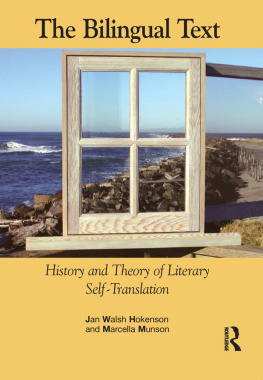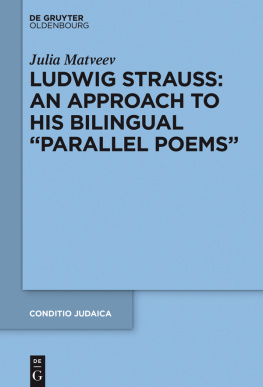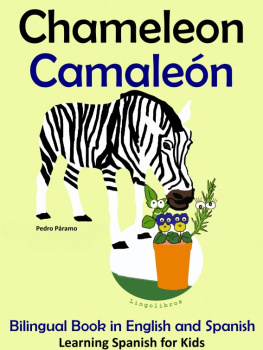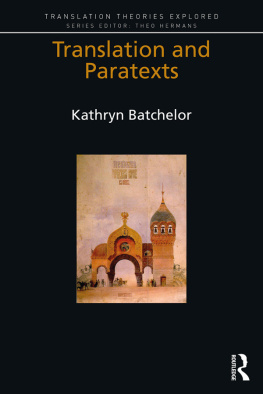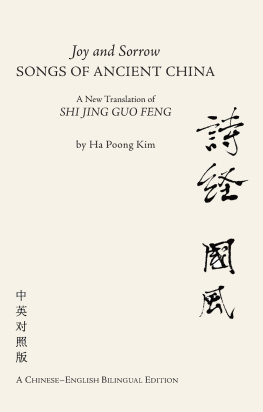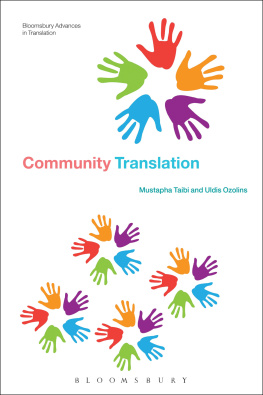First published 2007 by St. Jerome Publishing
Published 2014 by Routledge
2 Park Square, Milton Park, Abingdon, Oxon OX14 4RN
711 Third Avenue, New York, NY 10017, USA
Routledge is an imprint of the Taylor & Francis Group, an informa business
Jan Walsh Hokenson & Marcella Munson 2007
All rights reserved. No part of this book may be reprinted or reproduced or utilised in any form or by any electronic, mechanical, or other means, now known or hereafter invented, including photocopying and recording, or in any information storage or retrieval system, without permission in writing from the publishers.
Notices
Knowledge and best practice in this field are constantly changing. As new research and experience broaden our understanding, changes in research methods, professional practices, or medical treatment may become necessary.
Practitioners and researchers must always rely on their own experience and knowledge in evaluating and using any information, methods, compounds, or experiments described herein. In using such information or methods they should be mindful of their own safety and the safety of others, including parties for whom they have a professional responsibility.
To the fullest extent of the law, neither the Publisher nor the authors, contributors, or editors, assume any liability for any injury and/or damage to persons or property as a matter of products liability, negligence or otherwise, or from any use or operation of any methods, products, instructions, or ideas contained in the material herein.
ISBN 13: 978-1-900650-93-9 (hbk)
Typeset by
Delta Typesetters, Cairo, Egypt
British Library Cataloguing in Publication Data
A catalogue record of this book is available from the British Library
Library of Congress Cataloging-in-Publication Data
Hokenson, Jan
The bilingual text : history and theory of literary self-translation/Jan Walsh Hokenson & Marcella Munson.
p. cm.
Includes bibliographical references and index.
ISBN 1-900650-93-2 (pbk. : alk. paper)
1. Translating and interpreting. 2. Bilingualism and literature. 3.Bilingual authors. I. Munson, Marcella. II. Title.
PN241.H57 2006
418.02--dc22
2006032796
The Bilingual Text
Jan Walsh Hokenson and Marcella Munson
Bilingual texts have been left outside the mainstream of both translation theory and literary history. Yet the tradition of the bilingual writer, moving between different sign systems and audiences to create a text in two languages, is a rich and venerable one, going back at least to the Middle Ages. The self-translated, bilingual text was commonplace in the mutlilingual world of medieval and early modern Europe, frequently bridging Latin and the vernaculars. While self-translation persisted among cultured elites, it diminished during the consolidation of the nation-states, in the long era of nationalistic monolingualism, only to resurge in the postcolonial era.
The Bilingual Text makes a first step toward providing the fields of translation studies and comparative literature with a comprehensive account of literary self-translation in the West. It tracks the shifting paradigms of bilinguality across the centuries and addresses the urgent questions that the bilingual text raises for translation theoriststoday: Is each part of the bilingual text a separate, original creation or is each incomplete without the other? Is self-translation a unique genre? Can either version be split off into a single language or literary tradition? How can two linguistic versions of a text be fitted into standard models of foreign and domestic texts and cultures?
Because such texts defeat standard categories of analysis, The Bilingual Text reverses the usual critical gaze, highlighting not dissimilarities but continuities across versions, allowing for dissimilarities within orders of correspondence, and englobing the literary as well as linguistic and cultural dimensions of the text. Emphasizing the arcs of historical change in concepts of language and translation that inform each case study, The Bilingual Text examines the perdurance of this phenomenon in Western societies and literatures.
Jan Walsh Hokenson studied literature and language at the University of California at Berkeley and the University of Paris, before receiving her PhD in literature from the University of California at Santa Cruz. Currently Professor of French and Comparative Literature at Florida Atlantic University, she is the author of Japan, France, and East-West Aesthetics: French Literature, 18672000 (2004) and The Idea of Comedy: History, Theory, Critique (2006).
Marcella Munson is currently Head of French Studies and Assistant Professor of French and Comparative Literature at Florida Atlantic University. She received her PhD in French with an emphasis on medieval studies from the University of California at Los Angeles, and was a fellow of the UCLA Program in Critical Theory. She has published articles on verse narrative and epistolary prose in the medieval context, and is completing a book on late medieval authorship.
Acknowledgments
For allowing us to quote from their publications, we extend our gratitude to both Oxford University Press and to ditions Champion, for permission to quote from texts by Charles dOrlans, and to Western Michigan State University Press for permission to quote from texts by tienne Dolet.
We would like to extend warmest thanks to the many friends and colleagues who have helped bring The Bilingual Text to completion:
For their invaluable help in resolving fine points of translations or literary history:
Konstantinos Nikoloutsos
John Leeds
Martha Mendoza
Evelyn Trotter
Angela Martin
Yolanda Gamboa
Brian McConnell
Prisca Augustyn
Galina Paramonova
For their expertise in translating too, plus their crucial moral or intellectual support:
Anthony Tamburri
Rita Copeland
Nora Erro-Peralta
Michael Horswell
For reading parts of early drafts and supporting this project from the beginning to the end:
Mona Baker
Ruby Cohn
Dominique Desanti
For generously endowing the annual Howard M. Rosenblatt Distinguished Lecture in Translation Studies at Florida Atlantic University, which has brought fine scholars to students and to us:
Laurie Rosenblatt and the Rosenblatt Family
And especially, for their long-suffering largesse and many timely sacrifices, our partners Sandra Norton and Benjamin Kolstad.
Dedication
This book is dedicated to the many archivists, manuscript illuminators, printers, booksellers, editors, and publishers who have through the centuries helped bring self-translators work to the public.
Contents
Aims and Terms
What is the bilingual text? Like Bacons treatises or Nabokovs novels, the bilingual text is a self-translation, authored by a writer who can compose in different languages and who translates his or her texts from one language into another. Such self-translators have long been neglected in literary history and translation theory, and it is still often assumed that they are just rather idiosyncratic anomalies, mostly preening polyglots or maladaptive immigrants. Yet the tradition of the bilingual writer creating a single text in two languages, smoothly spanning different audiences, is a rich and venerable one, arising in Greco-Roman antiquity and thriving in the European Middle Ages and Renaissance. Self-translation was a common practice in the ambient translingual world of early modern Europe, when bilingualism was the norm, and writers increasingly translated between Latin and vernaculars.
Next page
